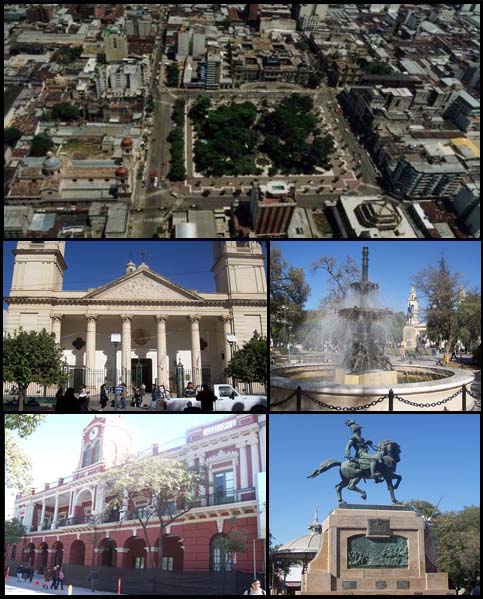Facts for Kids
Santiago del Estero is a historic city in Argentina famous for its warm climate, rich culture, and delicious cuisine.
Overview
Tourist Attractions
Geography And Climate
Sports And Recreation
Education And Institutions
Local Economy And Industries
History Of Santiago Del Estero
Cultural Heritage And Festivals
Gastronomy Of Santiago Del Estero
Transportation And Infrastructure
Notable People From Santiago Del Estero

Inside this Article
Infrastructure
Temperature
Basketball
Creativity
Argentina
Community
Livestock
Santiago
Spanish
Dessert
Culture
Did you know?
🇦🇷 Santiago del Estero is the capital city of Santiago del Estero Province in northern Argentina.
📅 Founded in 1553, it is one of the oldest cities in Argentina.
🌞 The city is known for its warm climate, with summer temperatures reaching up to 35°C (95°F).
🎉 Santiago del Estero is famous for its vibrant music and colorful festivals.
🏰 The city's establishment by Francisco de Aguirre helped to connect the Pampa region to northern Argentina.
📜 The city played an important role in Argentina's fight for independence in the 19th century.
🌾 Agriculture, especially crops like corn and cotton, plays a significant role in the local economy.
🍽️ Traditional foods like empanadas and locro are beloved in Santiago del Estero.
🛤️ The city's transportation system includes buses, taxis, and bicycles, making it easy to get around.
💖 Santiago del Estero is known as the 'Mother of Cities' for its role in establishing other cities in the region.
Introduction
With around 200,000 residents, it is one of the oldest cities in Argentina! It also holds the title of being the "Mother of Cities," as it helped establish other cities in the region. Santiago del Estero is famous for its music, delicious food, and colorful festivals! 🎉
Tourist Attractions
One must-see place is the "Iglesia de la Merced," a beautiful church built in the 17th century. The "Parque Aguirre" offers a fantastic space for picnics and nature walks 🌳. There’s also the "Museo de Historia y Arqueología," where you can learn about the local history and culture! People can enjoy the riverfront, where they can see stunning sunsets and spend time with friends and family. With festivals and music events throughout the year, there's always something fun to do! 🎈
Geography And Climate
The average temperature in summer can reach up to 35°C (95°F), while in winter, it can drop to around 8°C (46°F). The city experiences little rainfall, making it very dry. There are also beautiful green hills that surround the area, which adds to its scenic view! 🏞
️
Sports And Recreation
People love playing soccer, basketball, and rugby, with many local teams competing. The city has several parks and sports clubs where kids can join and stay active! 🏀
For more traditional sports, many participate in "pato," a horseback game unique to Argentina, which combines elements of basketball and polo. The warm climate allows for outdoor activities throughout the year, from hiking in nearby hills to enjoying the riverfront. Recreation brings everyone together to have fun and make friends! 🚴
♂️🌼
Education And Institutions
The National University of Santiago del Estero is an essential institution offering various courses and career opportunities. Children start their education in primary schools, and many continue on to high school. Community centers also provide after-school programs, helping children engage in art, music, and sports! 🏫
Education is valued in Santiago del Estero, with families encouraging kids to dream big and pursue their passions. Learning experiences are fun and exciting! 🌈
Local Economy And Industries
Agriculture plays a big role, with crops like cotton, corn, and soybeans being grown in the region. Livestock farming is also important, as it provides meat and dairy products. Many factories produce textiles, foods, and beverages, contributing to the local economy. The city is also becoming a trading hub, which means more businesses are opening up and creating jobs. 🌽💼 People in Santiago del Estero are busy working to ensure their community continues to thrive!
History Of Santiago Del Estero
Cultural Heritage And Festivals
Traditional music such as "zamba" and "chacarera" fills the streets, with vibrant dancing during celebrations. A fantastic festival held each year is the "Fiesta del Alferes Mayor," where people celebrate with music and dance. 🎊
The "Carnaval Santiagueño" also attracts many visitors with its colorful parades. The city's culture blends Indigenous, Spanish, and other influences, showing in its crafts and traditions. Families gather to celebrate numerous holidays, and the warmth of the people is felt throughout the entire community! 💖
Gastronomy Of Santiago Del Estero
️ One popular dish is "empanadas," which are baked or fried pastries filled with meat or cheese. Another tasty treat is "locro," a hearty soup made with corn and meat, perfect for cold days. For dessert, people enjoy "turrón," a sweet treat made of nuts and honey. 🌰
People also love drinking "mate," a traditional tea shared among friends. The city’s food reflects its diverse cultures, combining flavors that make meals special and memorable. Sharing food is an essential part of life here! ☕
Transportation And Infrastructure
The city has many buses, taxis, and cars that help people travel to work, school, and shops. There are also bicycles for those who prefer to pedal around town! 🚴
The main highway connects Santiago del Estero to other major cities, making it convenient for travelers. As for infrastructure, there are parks, hospitals, and shopping centers that provide essential services to the community. The city's commitment to developing public transportation ensures everyone can explore and enjoy all it offers! 🛤
️
Notable People From Santiago Del Estero
One famous figure is the singer Mercedes Sosa, known as the "voice of the voiceless." Her music celebrates Argentine culture and the struggles for social justice. Another notable person is novelist Manuel Belgrano, who became a national hero for his role in Argentina's independence. The city is proud of its talented artists, musicians, poets, and athletes, whose contributions enrich its history and culture. Santiago del Estero continues to foster creativity and passion in its people! 🎤📖

